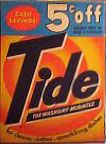

To the left, is Nestle’s hot chocolate package from around the 1930’s. This package was definitely limited by the printing at the time. There is only three printed colors. Everything is in a simple layout. The main font is rounded and the “instant” and “just add water” is in a script – very popular design method during this time. A script font made things look interesting. Also everything is in simple icon images. The kearning in “whole milk” is also very bad.
Compared to today’s design. Instead of an icon, we are not limited by printing. We can now print the actual image of the product. We can print in many colors and provide dimension in our package design. There is also noticeably less type. Because we provide that large image, text is not necessary.


 2012
2012 2012
2012


